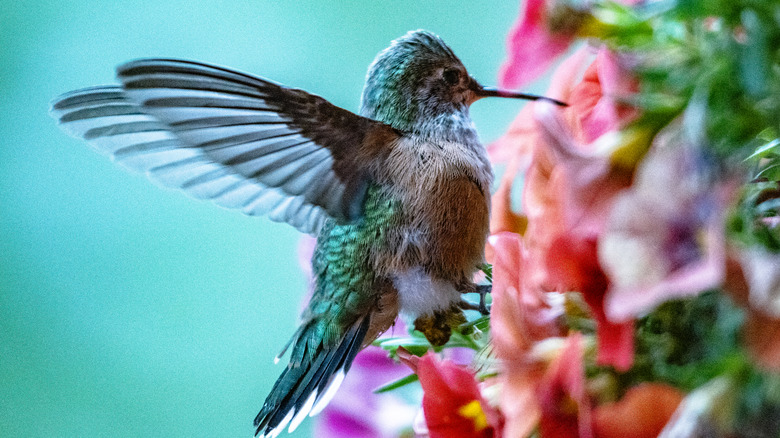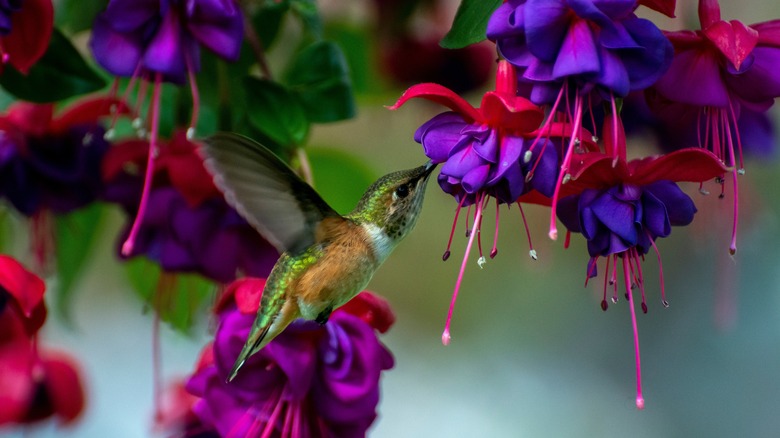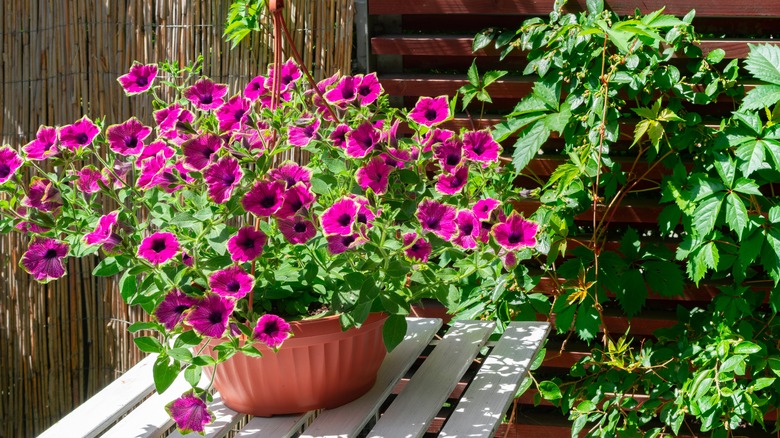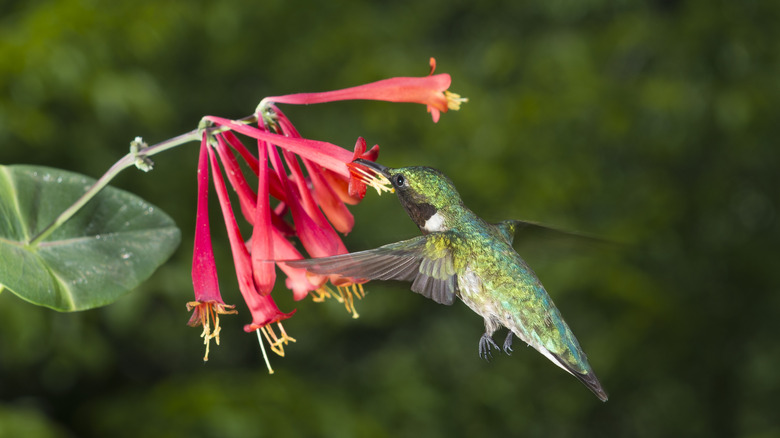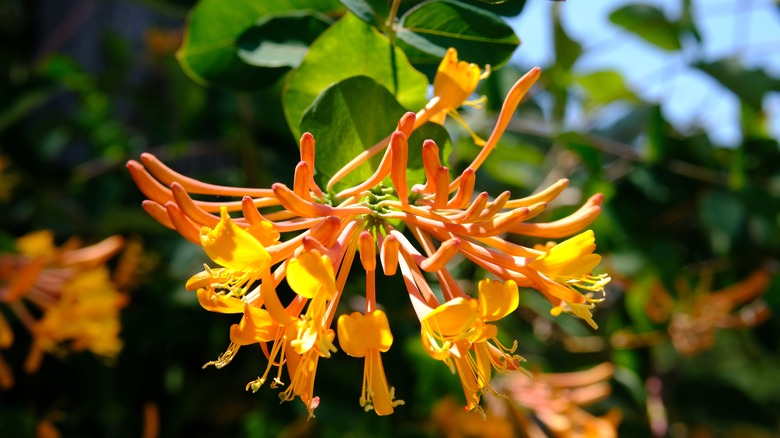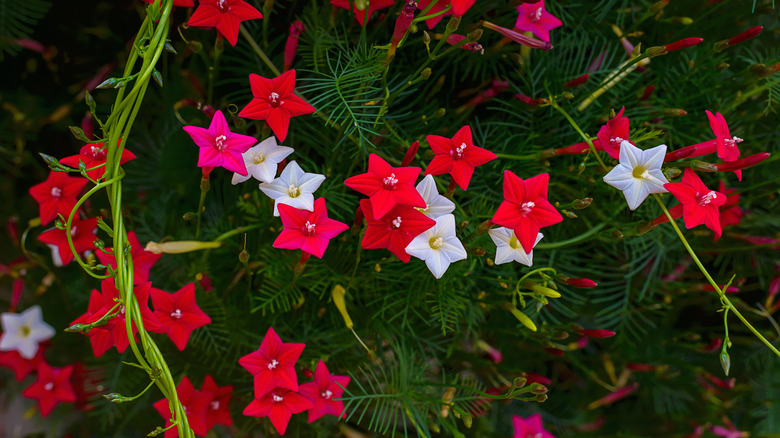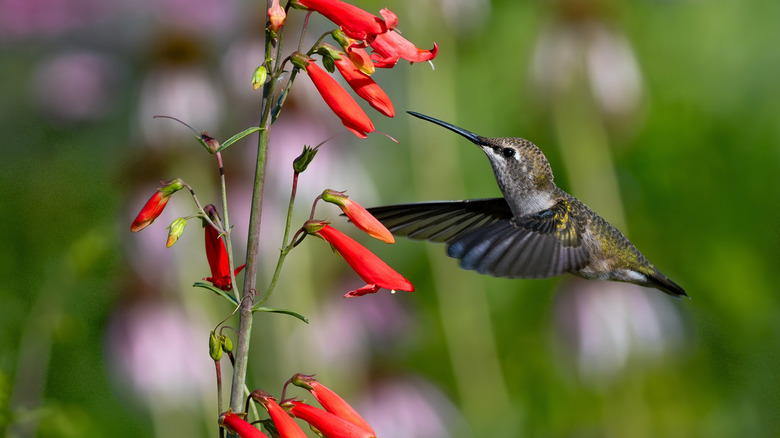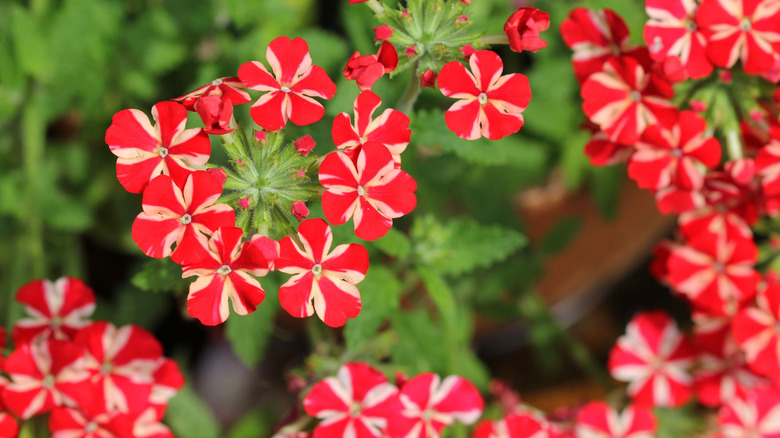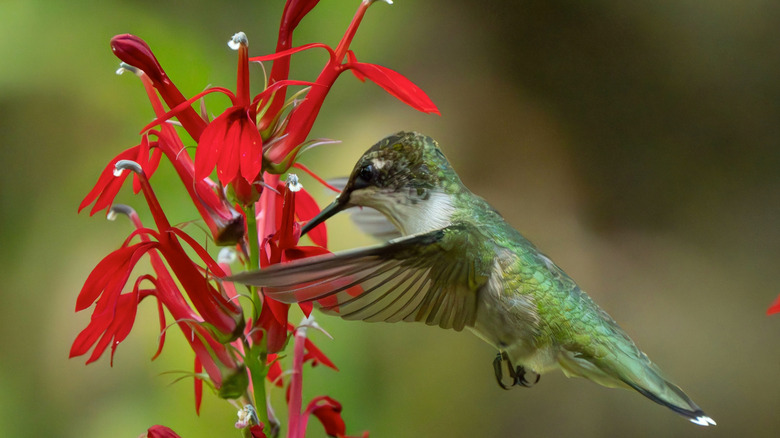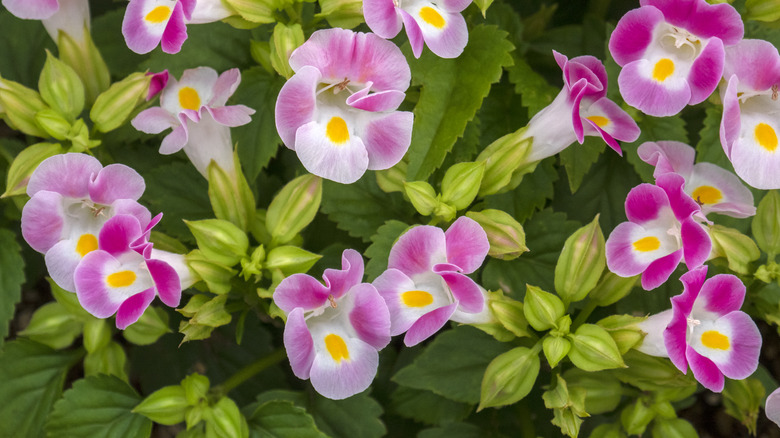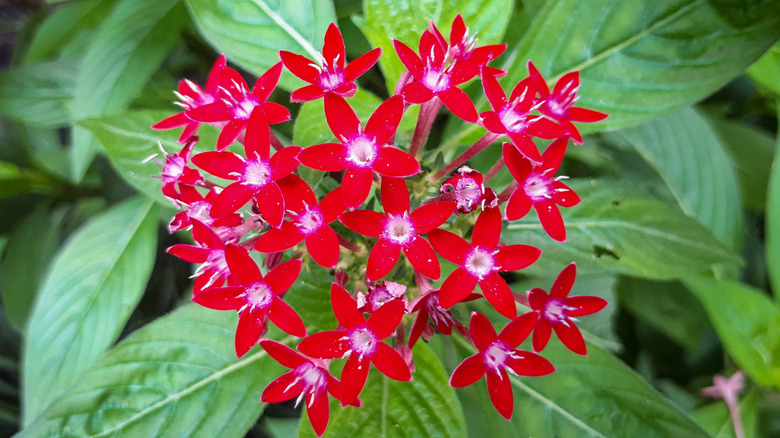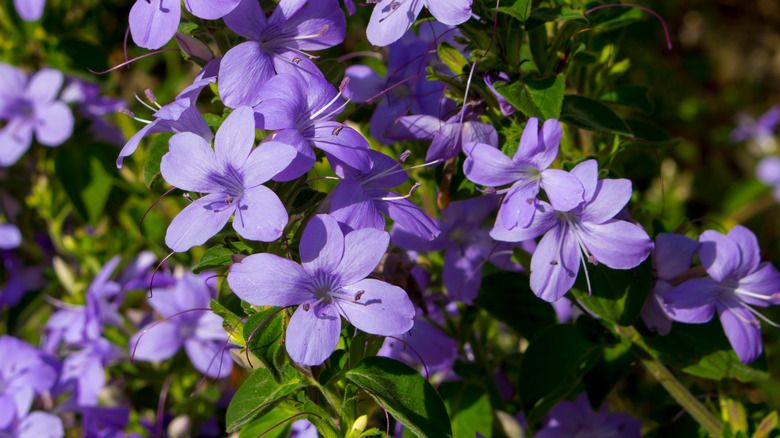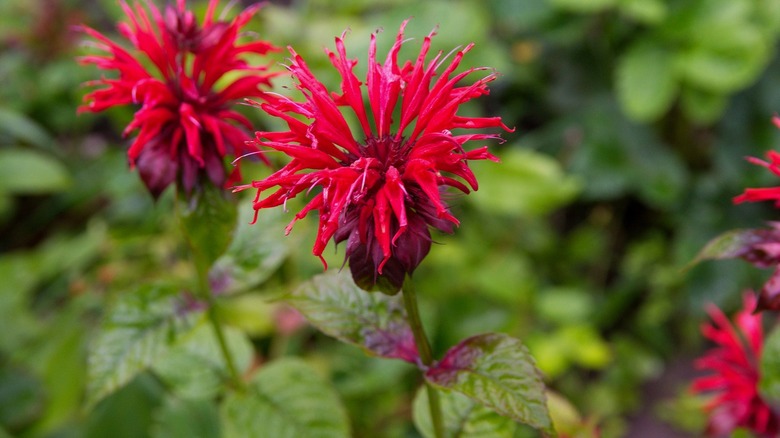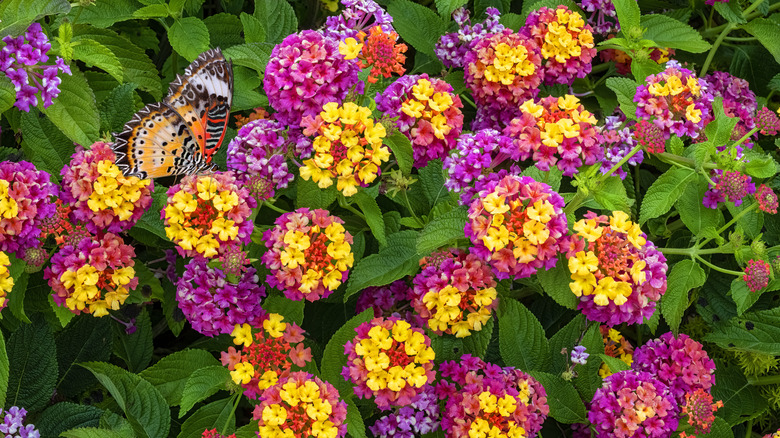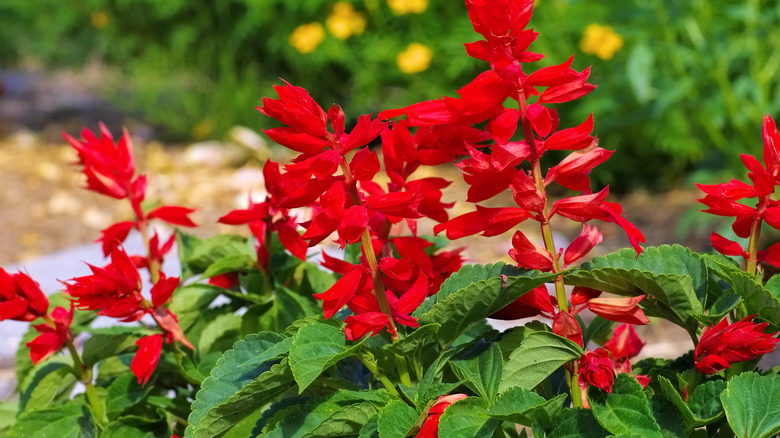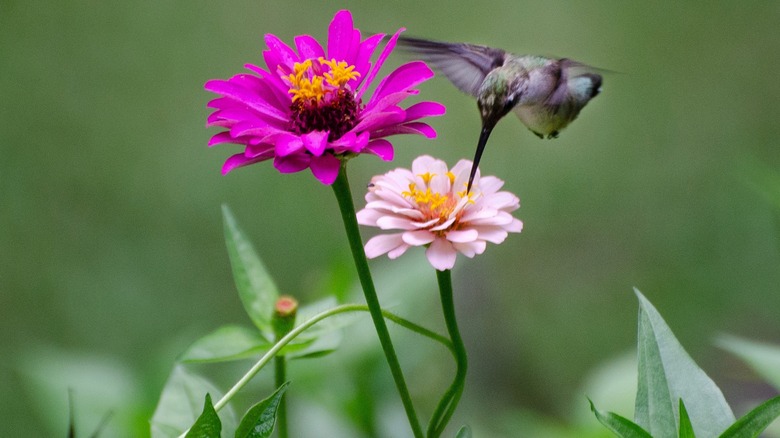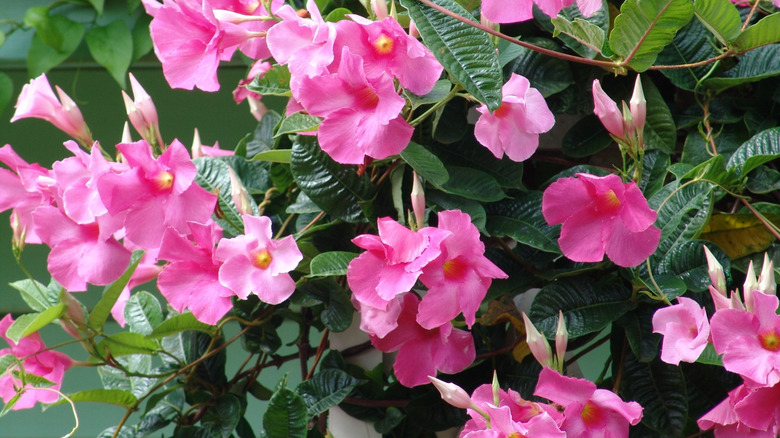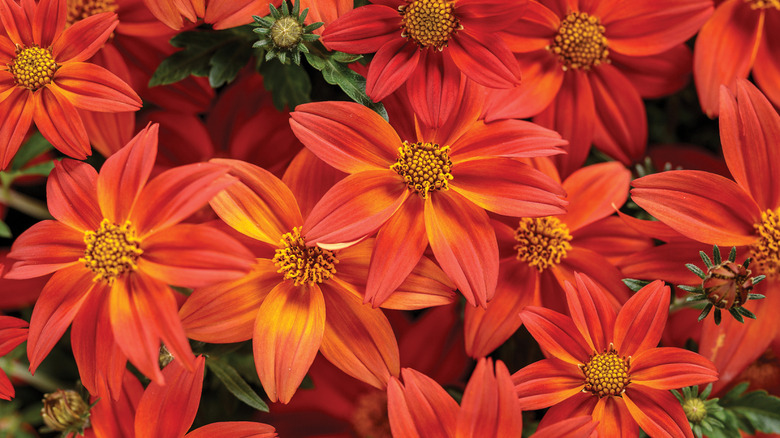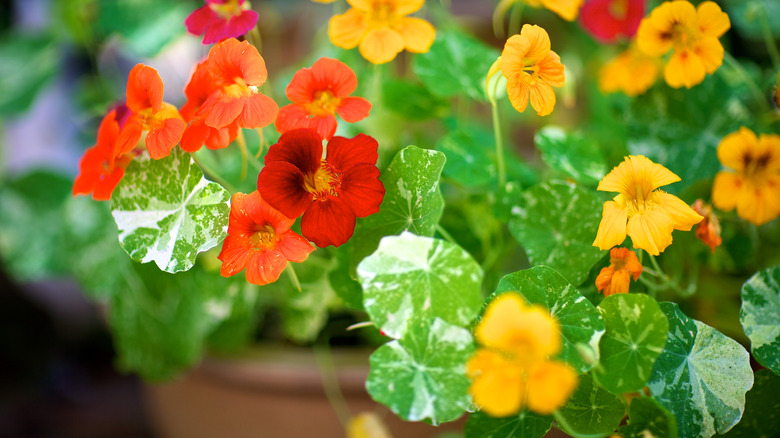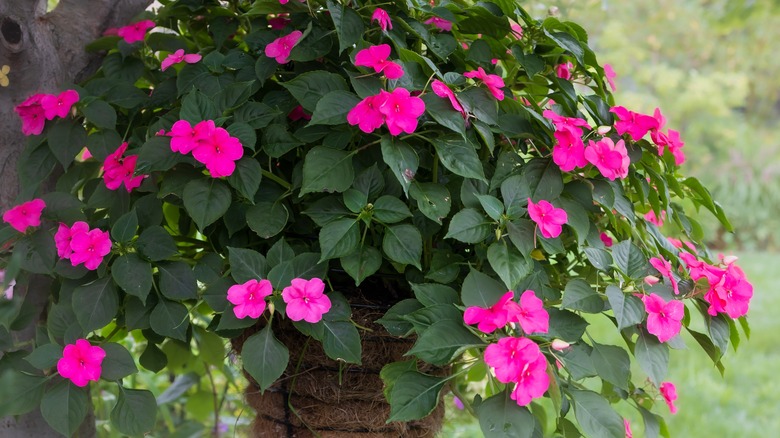19 Gorgeous Hanging Basket Plants That Hummingbirds Absolutely Love
One of the best parts of growing a lush flower garden is enjoying the view of the pollinators they attract, especially beautiful hummingbirds. Luckily, you don't need a huge backyard to entice hummers to visit; you just need a few of their favorite nectar-rich flowers. Hanging baskets create the perfect opportunity to attract these small birds, providing a buffet of nectar that's in their line of vision and easily accessible. If you're able to, choose a container that's at least 12 inches in diameter to create a truly eye-catching display for our feathered friends. Not only does a bigger floral arrangement make it easier for them to spot, but it also serves up enough nectar to fuel their nonstop flights.
If you want to attract more hummingbirds to your garden, place hanging baskets near some shrubbery or small trees to give them a quick retreat from predators or extreme weather. Place a water source nearby by either installing a birdbath or using a few thrifted gems to create an adorable water fountain for hummingbirds. By providing food, water, and shelter, they'll be more likely to stick around and even nest in your yard. Once you have your hummingbird haven set up, all that's left is choosing a few of their go-to plants, specifically those with nectar-rich, tubular blooms in warm shades, like red, pink, and orange. If you're not sure what to pick, we've rounded up the best flowers for hanging baskets that will keep the hummingbirds coming back.
Hardy fuchsia
If your hanging planters are set up in a low-light spot, then consider hardy fuchsias (Fuchsia magellanica) for your garden. These beautiful flowers grow perfectly in shade, putting out vibrant two-toned tubular flowers that cascade over container rims. Their bright red and purple blooms last from spring to frost and are a favorite of hummingbirds, bees, and other pollinators. Despite their exotic appearance, they're incredibly low-maintenance and are the hardiest of fuchsia flowers, growing well in USDA hardiness zones 5 to 10. Plant in fertile, well-drained soil in full sun to partial shade.
Supertunia petunias
Gardeners and petunias (Petunia x hybrida) go way back, but there's a must-plant hybrid you should grow to attract more hummingbirds. Supertunia petunias fill up containers with lush growth that looks stunning whether used as a filler or spiller. Pollinators will appreciate their nonstop blooms, and because they self-clean, you get constant color without the upkeep. Although they tolerate part sun, they flower most profusely in full sun. As long as you keep the soil consistently moist, they'll reward you from spring to frost. Treat them as perennials in zones 10 to 11 or as annuals everywhere else.
Coral honeysuckle
Coral honeysuckle (Lonicera sempervirens) is a go-to choice if you're looking for native plants to attract hummingbirds, particularly ruby-throated hummingbirds. This showy vine puts out clusters of scarlet to orange, trumpet-shaped blooms from March to July that will also bring in more butterflies and bees. Additionally, it's a larval host for the spring azure butterfly, and its attractive red berries feed songbirds. Grow this pollinator magnet in zones 4 to 9 in well-drained, acidic to neutral soil. While it can tolerate a bit of shade, it'll offer its best flowering in full sun with plenty of air circulation.
Yellow honeysuckle
If you love the look of honeysuckle but would rather have sunshine-colored blooms, give yellow honeysuckle (Lonicera flava) a try. Its nectar-filled golden trumpets draw in hummingbirds, while its cascading growth creates a lush, effortless look for hanging baskets. Flowering kicks off in late spring, delivering a sweet fragrance and early-season pop of color to decorate your garden before summer-blooming flowers emerge. Hardy in USDA zones 5 to 8, all this low-maintenance pollinator magnet asks for is moist, well-drained soil and full sun to part shade to thrive.
Cypress vine
With its attractive fern-like foliage contrasting beautifully against its bright scarlet, star-shaped flowers, Cypress vine (Ipomoea quamoclit) brings color and texture from mid-summer to fall. Hummingbirds, butterflies, and even specialized bees can't resist its nectar-rich blooms. It quickly fills out a hanging basket, so it's best planted alone to avoid overwhelming neighboring plants. While it's tolerant of both wet and dry conditions, it prefers consistently moist, well-drained soil and thrives in full sun. This annual grower is hardy in zones 11 to 12, often reappearing the following season through seed dispersal in warmer climates.
Fountainbush
Also called coral plant or firecracker plant, fountainbush (Russelia equisetiformis) is an annual that offers a tropical touch to baskets with its profuse, coral-red tubular blooms that lure in hummingbirds and butterflies from late spring through fall (or year-round in zones 9 to 11). While technically a shrub, its thin, arching stems give it a fountain-like form with sparse, needle-shaped leaves. It grows best in baskets hanging in a sunlit area in moist, well-drained soil, and tolerates dry spells once established. In cooler climates, overwinter near a sunny window as a houseplant to keep the color going all year.
Verbena
Butterflies, bees, and hummingbirds love verbena (Verbena bonariensis), and with its vibrant clusters and nonstop blooms, it's easy to see why this plant is a garden favorite, especially in hanging baskets. You can find it in shades of red, purple, pink, and white, with cultivars that come in a range of bicolor options. As a South American native, it's often grown as an annual, though it's winter hardy in zones 7 to 11. Once established, it's incredibly low-maintenance. You can plant it in a variety of soil types, and it thrives whether it receives full sun or partial shade.
Cardinal flower
If you've been searching for summer-blooming perennials that bring in more hummingbirds, butterflies, and bees, look no further than the breathtaking cardinal flower (Lobelia cardinalis). This native herbaceous perennial grows well anywhere in zones 3 to 9, gracing your garden with scarlet red, torch-like flower spikes that last until fall. Set up hanging baskets in an area with full sun, and plant cardinal flower in rich, medium to wet soil amongst other moisture-loving plants.
Wishbone flower
Thriving in shade, wishbone flower (Torenia fournieri) is a hanging basket flower that will look perfect on your porch. Each trumpet-shaped bloom is typically a two-toned bluish to purplish shade with an inner yellow marking, though it comes in a range of color combinations. Their trailing habit makes them perfect as a spiller plant, and hummingbirds and bees are among the pollinators that will visit as they search for nectar from June to the first frost. These tough flowers are hardy in zones 2 to 11, growing well in rich, moist soil in dappled sun to full shade.
Egyptian starcluster
For an easy-to-care-for flowering plant that hummingbirds love, you can't go wrong with using Egyptian starcluster (Pentas lanceolata) as an eye-catching standalone plant or filler in a hanging basket. While it's generally considered an annual, those in warmer climates of zones 10 and 11 can enjoy its return year after year. It blooms from summer to frost, producing pigmented clusters of star-shaped blooms that come in many shades, though you should consider a red variety to make them even more enticing to hummingbirds. For best flowering, plant in a full sun area in well-drained soil and water regularly.
Bush violet
For another beautiful flower that grows perfectly in shade, consider adding a compact or trailing variety of bush violet (Browallia speciosa) to your hanging basket. Its star-shaped, purplish-blue blooms last from summer to frost, attracting pollinators like butterflies and hummingbirds to your garden. It's winter hardy in zones 9 to 11 and likes warm weather, so it's typically grown as a warm-weather annual in most regions. Choose a spot in your yard where it'll get some sun with afternoon shade and add it to a container with moist, well-drained soil.
Bee balm
If you want to have a garden filled with an array of pollinators, your best bet is to add bee balm (Monarda didyma) somewhere in your floral display. This native herbaceous perennial features bright red flowers that form a shaggy, mop-like flower head, accentuated by its red-tinged, leafy bracts sitting beneath. Your favorite garden visitors, including ruby-throated hummingbirds, swallowtail butterflies, bumblebees, and a few specialized bees, will flock to your yard as it blooms from mid-to-late summer. You can grow bee balm in zones 4 to 9 in well-drained soil and full sun, though it tolerates some shade.
Lantana
Lantana (Lantana camara) is a stunning plant that'll have birds and butterflies flocking to your yard. Each rounded cluster is made up of varying singularly colored flowers that look sunset-inspired, with the different colors combined. There are several cultivars to choose from, like 'Bandito Red,' which is a vibrant, hummingbird-attracting shade. That said, all lantana flowers will bring in more hummingbirds and butterflies, while the berries are a favorite of songbirds. It's generally hardy in zones 7 to 11, with the option to overwinter indoors in cooler regions. As long as it's well-draining, this plant will tolerate poor soils.
Scarlet sage
Commonly known as hummingbird sage, scarlet sage (Salvia coccinea) is a stunning, low-maintenance perennial that is native to the southeastern United States. Its nectar-filled, rich, burgundy red flower spikes appear throughout the year in zones 8 to 10 or from summer to frost outside their hardiness range, attracting butterflies, bees, and hummingbirds. For best growth, choose an area with full sun to partial shade and plant it in containers with sandy, fertile soil that has good drainage. That said, it can tolerate clay if the soil is well-drained.
Zinnias
It's hard to resist the nonstop, colorful blooms that zinnias (Zinnia elegans) add to any garden. Their dome-shaped flowers come in an array of color options with varying heights, so choose a compact or trailing variety to attract hummingbirds, bees, and other pollinators to your hanging baskets. Hardy in zones 2 to 11, you can easily grow these low-maintenance annuals nearly anywhere in the United States. They thrive in full sun and aren't fussy about soil pH, though they do best in humusy, well-drained soil rich in organic matter.
Mandevilla
Mandevilla (Mandevilla × amabili) is a must-have annual vine to include in a tropical garden. Its funnel-shaped, oversized blooms add bursts of color to containers, with nectar that will have hummingbirds and butterflies swarming nearby. They bring drama throughout the seasons, typically appearing in late spring and lasting into fall. This coastal beauty is an herbaceous perennial in zones 10 to 11 and is grown as a houseplant or annual in other climates. It prefers moist, well-drained soil and appreciates some shade from the hot afternoon sun.
Bidens 'Campfire Flame'
Few plants bring sunshine to gardens quite like bidens, but the scarlet to orange hues of the 'Campfire Flame' hybrid are perfect for grabbing the attention of hummingbirds. Their mounding habit makes them a top choice for adding fiery color as a filler in hanging baskets, and butterflies and bees will also stop by for a drink. With self-cleaning blooms and some drought tolerance once established, it practically takes care of itself while keeping the flowers coming from spring to frost. That said, they prefer moist, well-drained soil and can thrive in full sun to full shade.
Nasturtium
Nasturtium (Tropaeolum majus) might be Meghan Markle's favorite edible flower, but hummingbirds and butterflies also enjoy their bright orange, yellow, or red funnel-shaped blooms from spring through fall. If you don't mind sharing with the pollinators, the leaves and flowers make a delicious, peppery addition to salads, while the seeds can be pickled to use as an alternative to capers. This easy-to-grow annual is winter hardy in zones 9 to 11 and creates a lush cascade of color in hanging baskets. Grow this edible flowering plant in full sun to part shade in slightly acidic, well-drained soil.
Impatiens
Impatiens (Impatiens walleriana) grow well in beds or containers, while fitting into nearly any landscape design. So, it's no surprise that these versatile annuals look stunning when they fill out and gently hang over baskets, bringing in a swarm of pollinators like hummingbirds and butterflies. Their delicate, pinwheel-like blooms come in nearly every color of the rainbow, adding vibrant impact to the garden from June to frost, though they're winter-hardy in zones 10 to 11. They're easily grown in shady conditions, only asking for moist, organically rich, well-drained soils to thrive.
